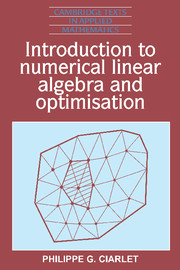Preface
Published online by Cambridge University Press: 12 October 2018
Summary
My main purpose in writing this textbook was to give, within reasonable limits, a thorough description, and a rigorous mathematical analysis, of some of the most commonly used methods in Numerical Linear Algebra and Optimisation.
Its contents should illustrate not only the remarkable efficiency of these methods, but also the interest per se of their mathematical analysis. If the first aspect should especially appeal to the more practically oriented readers and the second to the more mathematically oriented readers, it may be also hoped that both kinds of readers could develop a common interest in these two complementary aspects of Numerical Analysis.
This textbook should be of interest to advanced undergraduate and beginning graduate students in Pure or Applied Mathematics, Mechanics, and Engineering. It should also be useful to practising engineers, physicists, biologists, economists, etc., wishing to acquire a basic knowledge of, or to implement, the basic numerical methods that are constantly used today.
In all cases, it should prove easy for the instructor to adapt the contents to his or her needs and to the level of the audience. For instance, a three hours per week, one-semester, course can be based on Chapters 1 to 6, or on Chapters 7 to 10, or on Chapters 4 to 8.
The mathematical prerequisites are relatively modest, especially in the first part. More specifically, I assumed that the readers are already reasonably familiar with the basic properties of matrices (including matrix computations) and of finite-dimensional vector spaces (continuity and differentiability of functions of several variables, compactness, linear mappings). In the second part, where various results are presented in the more general settings of Banach or Hilbert spaces, and where differential calculus in general normed vector spaces is often used, all relevant definitions and results are precisely stated wherever they are needed. Besides, the text is written in such a way that, in each case, the reader not familiar with these more abstract situations can, without any difficulty, ‘stay in finite-dimensional spaces’ and thus ignore these generalisations (in this spirit, weak convergence is used for proving only one ‘infinite-dimensional’ result, whose elementary ‘finite-dimensional’ proof is also given).
Information
- Type
- Chapter
- Information
- Introduction to Numerical Linear Algebra and Optimisation , pp. xi - xivPublisher: Cambridge University PressPrint publication year: 1989
